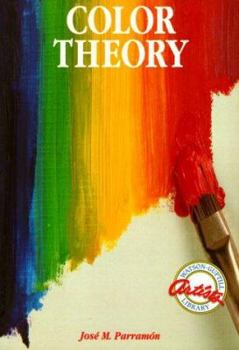Color Theory (Watson-Guptill Artist's Library)
This guide explains how colour works in nature and how it can be manipulated to make expressive paintings. After covering the more scientific aspects of colour theory, the author offers information... This description may be from another edition of this product.
Format:Paperback
Language:English
ISBN:0823007553
ISBN13:9780823007554
Release Date:January 1989
Publisher:Watson-Guptill Publications
Length:111 Pages
Weight:0.80 lbs.
Dimensions:0.3" x 7.1" x 10.2"
Customer Reviews
5 ratings
Very clear and understandable!
Published by Thriftbooks.com User , 17 years ago
Although oriented toward oil painters, Jose Parramon's color theory book is enlightening and informative for anyone who wishes to understand color. He explains the theory very simply and clearly, illustrating concepts with pertinent color examples from oil painting. As a photoshop instructor helping my students understand color both on screen (made with light) and in print, and as a photographer seeking to capture harmonious images, I found the book to be very helpful in clarifying my understanding of color. I was pleased also to learn about the color of shadows, and how colors cast their complementary color onto neighboring objects - knowledge that helps not only with painting but also in regard to touching up photographs.
José is a FANTASTIC Art Teacher!
Published by Thriftbooks.com User , 20 years ago
I paint landscapes in oil for a hobby. The other day, while cleaning all my paint tubes, and while looking at the names of the colors, I began thinking about them. I then found I had José's wonderful book on my shelf for several years, still unread. I picked it up, and found I literally could not put it down. For an artist, this book reads like a "thriller!"One of the things I liked best about the book is that it is not necessary to read it in order, from beginning to end. I turned first to the section on shadows, as shadows are an area I am currently having problems with. José explains EVERYTHING SO WELL, and CLEARLY. When he refers to matter already covered in an earlier section of the book, he clearly states the page number, where you can go back and refer to that section. His treatment of shadows is typical of how he addresses each subject in his little book. José opens the chapter with a brief discussion of what Van Gogh once said about shadows, and discusses how artists currently view shadows as blue; whereas, at one time, they were viewed as similar to Van Dyck brown, or burnt umber. He explains how the post-impressionists discovered that the basic color of shadows is blue, and he devotes an entire lesson to actually showing us how that is so. Next, he devotes a second lesson to understanding the local color in darker tones, which he also points out is somewhat reminiscent of an old master's painting. In the first lesson, he gives us a sample still life painting, all in shades of blue. In the second lesson, we see the same still life painting, where the shadows are not made with blue, but only by using darker tones of the local colors. The third lesson deals with the complementary color of the local color. Here, we are given a third example of the still life, painted this time in complementary colors, which are used as shadows. José also points out that the still life now looks very much like the style of some paintings by Toulouse-Lautrec, Cézanne, and especially Van Gogh, with the contrast originating from the juxtaposition of the most opposed colors, of highest contrast. He is not advising us to paint like this, only to help us understand. The fourth lesson in the chapter deals with the finished painting. We now see the same still life painted correctly, with proper use three types of colors in the shadows: blue, the local color in darker tones, and the complementary of the local color. As José carefullly guides our eye through each step of the process, we now really understand what he wants us to see!I then read the other chapters, in order from the beginning. One of the best discussions dealt with looking at various landscape scenes (shown in photographs) and how each painter asks himself, "What color is it, actually?" He then takes us through a whole lesson, showing us his own thoughts (and sometimes, confusion) as he paints the landscape, trying to decide what color each thing is. This really helped me s
Very good discussion of color theory
Published by Thriftbooks.com User , 21 years ago
Unlike some of the past reviewers, I liked the use of the more technical CMYK colors as the primary rather than the RGB. I especially enjoyed the discussion of additive color changes and subtractive color changes. I work in stained glass and thus work with both methods of altering colors. It is important to me both how the glass will look when looked at directly and also how the colors will look when it is as transmitted light casting colors onto the surrounding room. Highly recommended.
The Primary Color He Lists.....
Published by Thriftbooks.com User , 22 years ago
...Are absolutely correct. The previous reviewer isincorrect. Do a search on the web for primary colorsand you will see this is true.And, I love the book.
"Color Theory (Watson-Guptill Artist's Library)"
Published by Thriftbooks.com User , 24 years ago
An excellent resource for all wishing a better understanding of the nature of and relationship of colors. Parramon provides basic knowledge of how light breaks down into colors, in layman's terms, and then applies same to pigments. He then expands into contrasts, harmony, use and mis-use of black and white, a comprehensive discussion of artist colors, painting shadows and so on. Each topic is well addressed and supported visually.Again, an excellent book which I'm delighted to have in my library, albeit covered with pastel and watercolor fingerprints.






